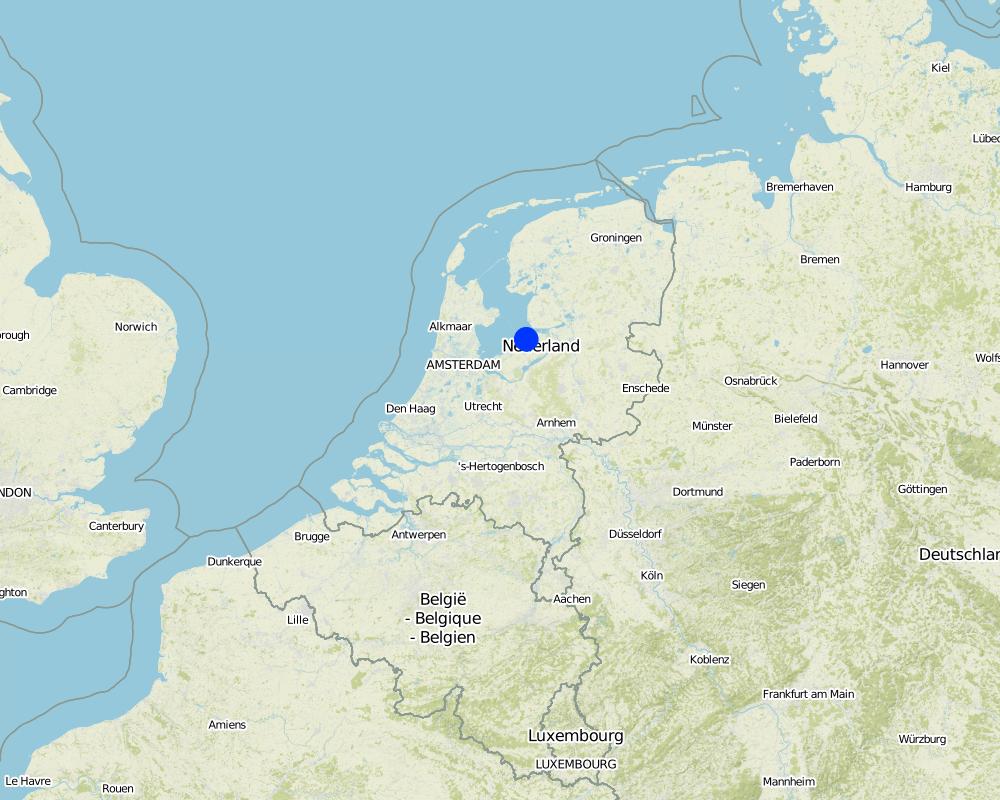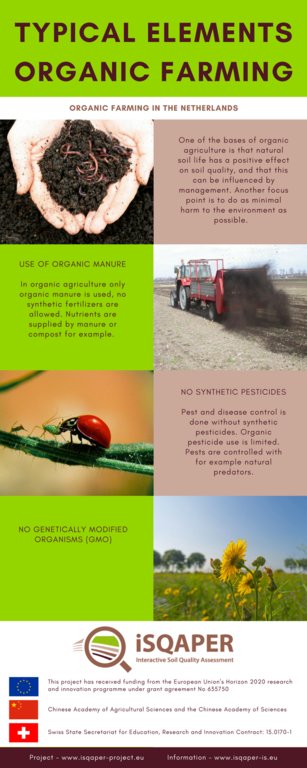Organic agriculture with vegetable and arable crops on sandy loam soils [荷兰]
- 创建:
- 更新:
- 编制者: Marie Wesselink
- 编辑者: –
- 审查者: Gudrun Schwilch, Ursula Gaemperli
Biologische landbouw met groente en akkerbouw gewassen op zandige leem
technologies_3305 - 荷兰
查看章节
全部展开 全部收起1. 一般信息
1.2 参与该技术评估和文件编制的资源人员和机构的联系方式
有助于对技术进行记录/评估的项目名称(如相关)
Interactive Soil Quality assessment in Europe and China for Agricultural productivity and Environmental Resilience (EU-iSQAPER)有助于对技术进行记录/评估的机构名称(如相关)
Stichting Dienst Landbouwkundig Onderzoek, Wageningen University & Research Centre (DLO) - 荷兰1.3 关于使用通过WOCAT记录的数据的条件
(现场)数据是什么时候汇编的?:
20/11/2017
编制者和关键资源人员接受有关使用通过WOCAT记录数据的条件。:
是
1.4 所述技术的可持续性声明
这里所描述的技术在土地退化方面是否存在问题,导致无法被认为是一种可持续的土地管理技术?:
否
2. SLM技术的说明
2.1 技术简介
技术定义:
Certified Organic Agriculture (EU standards) with a combination of arable and vegetable crops on sandy loam soils in the Netherlands
2.2 技术的详细说明
说明:
The technology is in this specific case applied on sandy loam soils in the Netherlands. It is not limited to those specific conditions. Organic agriculture could as well be applied on other soil types, and it could be applied in various cropping systems as well. There are no environmental limitations known which would prevent a farmer from applying certified organic agriculture on his farm fields.
The characteristics which a system has to fulfill to be certified organic agriculture are to be found in the standards for organic production in the EU (Council Regulation (EC) No 834/2007). Main points in this standard are: no application of synthetic pesticides and no use of synthetic fertilizer. Next to that, there are certain specifications on how many crops you need to have as a minimum in your rotation etc. The purpose of this technology is a sustainable production in general. The idea behind is, that with more care and attention for your production, without the use of synthetic products, you will have a more sustainable and resilient system.
The major input in organic agriculture is organic manure. Because synthetic fertilizers are not allowed more care and attention is paid to apply the right amount of the right organic fertilizers. In general this leads to higher inputs of organic matter to the soil.
The positive impacts of organic agriculture are:
- better general soil quality (more organic matter, better structure, higher fertility, more soil life, more diverse soil life)
- better water holding capacity
- reduced nitrate leaching to the groundwater
- good economic impact (with the label 'organic' farmers can sell their products for a higher price)
Organic agriculture (compared to conventional) also has a negative impact: yields are in general up to 20% lower than conventional production. This yield reduction is mainly caused by pests and diseases, because no synthetic pesticides are allowed, the control of many diseases and pests is not possible.
Land users like this technique because it is actually more than just an application of a technique, it is a way of farming. Organic farming calls upon the craftmanship of the farmers. They like it because they know they are contributing to a more sustainable farming system. Farmers may dislike it because it is complicated to obtain the same yields as with conventional agriculture, and because it is not yet possible to control all pests and diseases.
2.5 已应用该技术的、本评估所涵盖的国家/地区/地点
国家:
荷兰
区域/州/省:
Flevoland - Flevopolder
有关地点的进一步说明:
Surroundings of Lelystad
Map
×2.6 实施日期
注明实施年份:
2009
2.7 技术介绍
详细说明该技术是如何引入的:
- 通过土地使用者的创新
- 在实验/研究期间
- 通过项目/外部干预
注释(项目类型等):
Researchers, policy makers and farmers are all more and more aware that it is important to work towards a more sustainable farming system. At first, organic agriculture was mainly applied within research and by precursor farmers, but it is becoming more common and widespread.
3. SLM技术的分类
3.1 该技术的主要目的
- 减少、预防、恢复土地退化
- 保持/提高生物多样性
- 适应气候变化/极端天气及其影响
- 创造有益的经济影响
3.2 应用该技术的当前土地利用类型

农田
- 一年一作
3.3 有关土地利用的更多信息
该技术所应用土地的供水:
- 混合雨水灌溉
每年的生长季节数:
- 1
具体说明:
The climate is limiting the growing season
3.4 该技术所属的SLM组
- 轮作制度(轮作、休耕、轮垦)
- 土壤肥力综合管理
- 病虫害综合管理(包括有机农业)
3.5 技术传播
具体说明该技术的分布:
- 均匀地分布在一个区域
如果该技术均匀地分布在一个区域上,请注明覆盖的大致区域。:
- 0.1-1 平方千米
注释:
At this farm, they have 60 hectares of organic agriculture
3.6 包含该技术的可持续土地管理措施

农艺措施
- A1:植被和土壤覆盖层
- A2:有机质/土壤肥力

管理措施
- M2:改变管理/强度级别
3.7 该技术强调的主要土地退化类型

土壤风蚀
- Et:表土流失

化学性土壤退化
- Cn:肥力下降和有机质含量下降(非侵蚀所致)

物理性土壤退化
- Pc:压实

生物性退化
- Bs:质量和物种组成/多样性的下降
- Bl:土壤寿命损失

水质恶化
- Hq:地下水水质下降
3.8 防止、减少或恢复土地退化
具体数量名该技术与土地退化有关的目标:
- 防止土地退化
4. 技术规范、实施活动、投入和成本
4.1 该技术的技术图纸
4.2 技术规范/技术图纸说明
The most important aspects of organic agriculture are: application of only organic manure and no application of synthetic pesticides, with the idea that soil quality and environment can be positively effected by this.
4.3 有关投入和成本计算的一般信息
具体说明成本和投入是如何计算的:
- 每个技术区域
注明尺寸和面积单位:
50 hectares
其它/国家货币(具体说明):
euro
注明美元与当地货币的汇率(如相关):1美元=:
0.87
注明雇用劳工的每日平均工资成本:
160
4.4 技术建立活动
| 活动 | 措施类型 | 时间 | |
|---|---|---|---|
| 1. | Adapt/change machinery | 管理 | before and during conversion to organic |
| 2. | Stop using synthetic pesticides | 管理 | before conversion to organic |
| 3. | Stop using synthetic fertilizers | 管理 | before conversion to organic |
| 4. | Choose conversion period crops | 农业学的 | 2 years before start certified organic production |
| 5. | start conversion period | 管理 | 2 years before start certified organic production |
| 6. | Design and adapt crop choice and rotation | 农业学的 | Before/during and after conversion |
4.5 技术建立所需要的费用和投入
| 对投入进行具体说明 | 单位 | 数量 | 单位成本 | 每项投入的总成本 | 土地使用者承担的成本% | |
|---|---|---|---|---|---|---|
| 设备 | Investment in mechanical weed control machine | piece | 1.0 | 5000.0 | 5000.0 | 100.0 |
| 技术建立所需总成本 | 5000.0 | |||||
注释:
The costs for establishing organic agriculture are hard to estimate, it depends on the farm specific situation. Anyway, there will be a need to adapt machinery for the weed control. there will be a loss (in turnover and profitability) in the conversion period, because crops grown in this period are organically managed, but cannot yet be sold as organic.
4.6 维护/经常性活动
| 活动 | 措施类型 | 时间/频率 | |
|---|---|---|---|
| 1. | Mechanical weed control instead of herbicides | 农业学的 | each cropping season |
| 2. | Handlabour for weed control | 农业学的 | each cropping season |
| 3. | Spread of organic fertilizers instead of synthetic fertilizer | 农业学的 | each cropping season |
注释:
These are the biggest, most important activities that change by converting from conventional to organic. There are more smaller activities not listed here.
4.7 维护/经常性活动所需要的费用和投入(每年)
| 对投入进行具体说明 | 单位 | 数量 | 单位成本 | 每项投入的总成本 | 土地使用者承担的成本% | |
|---|---|---|---|---|---|---|
| 劳动力 | Additional handlabour mostly for weeding | hours | 250.0 | 160.0 | 40000.0 | 100.0 |
| 劳动力 | Additional labour for mechanical weed control | hours | 75.0 | 160.0 | 12000.0 | 100.0 |
| 设备 | Yearly costs of weed control mechanization | euro | 1.0 | 5000.0 | 5000.0 | 100.0 |
| 技术维护所需总成本 | 57000.0 | |||||
注释:
The additional costs (compared to conventional) and yield losses are most of the time more than covered by additional income because of premium product prices. Costs are calculated for a 50 ha farm.
4.8 影响成本的最重要因素
描述影响成本的最决定性因素:
Increase in labour for weed control
5. 自然和人文环境
5.1 气候
年降雨量
- < 250毫米
- 251-500毫米
- 501-750毫米
- 751-1,000毫米
- 1,001-1,500毫米
- 1,501-2,000毫米
- 2,001-3,000毫米
- 3,001-4,000毫米
- > 4,000毫米
指定年平均降雨量(若已知),单位为mm:
800.00
注明所考虑的参考气象站名称:
Lelystad
农业气候带
- 半湿润
5.2 地形
平均坡度:
- 水平(0-2%)
- 缓降(3-5%)
- 平缓(6-10%)
- 滚坡(11-15%)
- 崎岖(16-30%)
- 陡峭(31-60%)
- 非常陡峭(>60%)
地形:
- 高原/平原
- 山脊
- 山坡
- 山地斜坡
- 麓坡
- 谷底
垂直分布带:
- 0-100 m a.s.l.
- 101-500 m a.s.l.
- 501-1,000 m a.s.l.
- 1,001-1,500 m a.s.l.
- 1,501-2,000 m a.s.l.
- 2,001-2,500 m a.s.l.
- 2,501-3,000 m a.s.l.
- 3,001-4,000 m a.s.l.
- > 4,000 m a.s.l.
说明该技术是否专门应用于:
- 不相关
关于地形的注释和进一步规范:
The area is reclaimed land from the sea, it is therefore about 3 meters below sealevel.
5.3 土壤
平均土层深度:
- 非常浅(0-20厘米)
- 浅(21-50厘米)
- 中等深度(51-80厘米)
- 深(81-120厘米)
- 非常深(> 120厘米)
土壤质地(表土):
- 中粒(壤土、粉土)
土壤质地(地表以下> 20厘米):
- 中粒(壤土、粉土)
表土有机质:
- 高(>3%)
- 中(1-3%)
如有可能,附上完整的土壤描述或具体说明可用的信息,例如土壤类型、土壤酸碱度、阳离子交换能力、氮、盐度等。:
Remark: the organic matter in the topsoil is around 3%
5.4 水资源可用性和质量
地下水位表:
< 5米
地表水的可用性:
好
水质(未处理):
仅供农业使用(灌溉)
水的盐度有问题吗?:
否
该区域正在发生洪水吗?:
否
5.5 生物多样性
物种多样性:
- 中等
栖息地多样性:
- 低
5.6 应用该技术的土地使用者的特征
定栖或游牧:
- 定栖的
生产系统的市场定位:
- 商业/市场
非农收入:
- 低于全部收入的10%
相对财富水平:
- 丰富
个人或集体:
- 个人/家庭
机械化水平:
- 机械化/电动
性别:
- 男人
土地使用者的年龄:
- 中年人
5.7 应用该技术的土地使用者拥有或租用的平均土地面积
- < 0.5 公顷
- 0.5-1 公顷
- 1-2 公顷
- 2-5公顷
- 5-15公顷
- 15-50公顷
- 50-100公顷
- 100-500公顷
- 500-1,000公顷
- 1,000-10,000公顷
- > 10,000公顷
这被认为是小规模、中规模还是大规模的(参照当地实际情况)?:
- 中等规模的
5.8 土地所有权、土地使用权和水使用权
土地所有权:
- 个人,未命名
土地使用权:
- 个人
用水权:
- 社区(有组织)
5.9 进入服务和基础设施的通道
健康:
- 贫瘠
- 适度的
- 好
教育:
- 贫瘠
- 适度的
- 好
技术援助:
- 贫瘠
- 适度的
- 好
就业(例如非农):
- 贫瘠
- 适度的
- 好
市场:
- 贫瘠
- 适度的
- 好
能源:
- 贫瘠
- 适度的
- 好
道路和交通:
- 贫瘠
- 适度的
- 好
饮用水和卫生设施:
- 贫瘠
- 适度的
- 好
金融服务:
- 贫瘠
- 适度的
- 好
6. 影响和结论性说明
6.1 该技术的现场影响
社会经济效应
生产
作物生产
注释/具体说明:
Crop yields in organic agriculture are up to 20% lower compared to conventional
收入和成本
农业投入费用
注释/具体说明:
Organic planting material is more expensive than conventional
农业收入
注释/具体说明:
Per product organic farmers will get a higher price
工作量
注释/具体说明:
The use of (hand)weeding increases because of no herbicide use
生态影响
水循环/径流
地表径流
注释/具体说明:
Due to better soil structure runoff is limited, therefor the water holding capacity and natural drainage of the soil improves.
土壤
土壤水分
注释/具体说明:
Due to higher organic matter (manure) inputs the water holding capacity of the soil improves.
土壤覆盖层
注释/具体说明:
In general, soils used in organic agriculture are covered during more months within a year, due to more usage of cover crops in winter season for example
养分循环/补给
注释/具体说明:
More attention is paid to the nutrientcycles, cover crops are used to maintain nutrients for the next season
土壤有机物/地下C
注释/具体说明:
More organic matter is applied, slowly this will lead to a higher content in the soil
生物多样性:植被、动物
植物多样性
注释/具体说明:
No use of pesticides gives the opportunity for a diverse range of plants to develop
有益物种
注释/具体说明:
Pesticides can also harm the beneficial species, no pesticides = more benificial species
栖息地多样性
注释/具体说明:
The whole agricultural system gets more diverse due to more organic inputs and less pesticide inputs
害虫/疾病控制
注释/具体说明:
It is harder to control pests and diseases, when synthetic pesticides are not allowed. There is no organic cure for all pests and diseases (yet)
减少气候和灾害风险
干旱影响
注释/具体说明:
Due to better soil structure the soil is less vulnerable for drought events
6.2 该技术的场外影响已经显现
地下水/河流污染
注释/具体说明:
With organic agriculture there is less nitrate leaching
6.3 技术对渐变气候以及与气候相关的极端情况/灾害的暴露和敏感性(土地使用者认为的极端情况/灾害)
气候有关的极端情况(灾害)
气候灾害
| 该技术是如何应对的? | |
|---|---|
| 干旱 | 好 |
6.4 成本效益分析
技术收益与技术建立成本相比如何(从土地使用者的角度看)?
短期回报:
中性/平衡
长期回报:
积极
技术收益与技术维护成本/经常性成本相比如何(从土地使用者的角度看)?
短期回报:
稍微积极
长期回报:
积极
6.5 技术采用
- 1-10%
在所有采用这项技术的人当中,有多少人是自发地采用该技术,即未获得任何物质奖励/付款?:
- 90-100%
注释:
There is no support/financial compensation from governments. Switching to organic agriculture is driven by the mindset that taking good care of the soil and environment is crucial for the future of agriculture
6.6 适应
最近是否对该技术进行了修改以适应不断变化的条件?:
否
6.7 该技术的优点/长处/机会
| 土地使用者眼中的长处/优势/机会 |
|---|
| better soil quality |
| more income per product |
| challenges your farmer skills |
| 编制者或其他关键资源人员认为的长处/优势/机会 |
|---|
| more sustainable |
| more resilient |
| less nitrate leaching |
6.8 技术的弱点/缺点/风险及其克服方法
| 土地使用者认为的弱点/缺点/风险 | 如何克服它们? |
|---|---|
| More handlabour for weeding | improve mechanical weeding techniques, more craftmanship |
| more losses due to pests and diseases | resistant varieties,enhancement of natural enemies, more crop diversity |
| more work to market your products | better market organisation, cooperation |
| 编制者或其他关键资源人员认为的弱点/缺点/风险 | 如何克服它们? |
|---|---|
| High dependancy on manure from animal husbandry in the region | mixed farms, cooperation between organic animal farms and organic arable farms |
| risk of dependency on biopesticides | More resilient production systems, resistant |
7. 参考和链接
7.1 信息的方法/来源
- 与土地使用者的访谈
Landowner and some landworkers provided information
- 与SLM专业人员/专家的访谈
Involved researchers were consulted
链接和模块
全部展开 全部收起链接
无链接
模块
无模块



